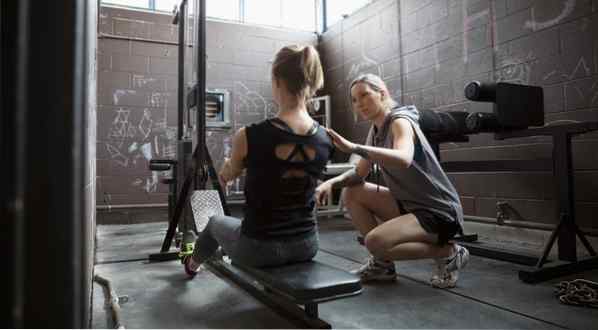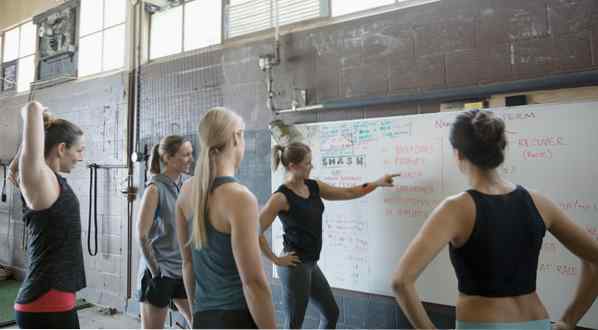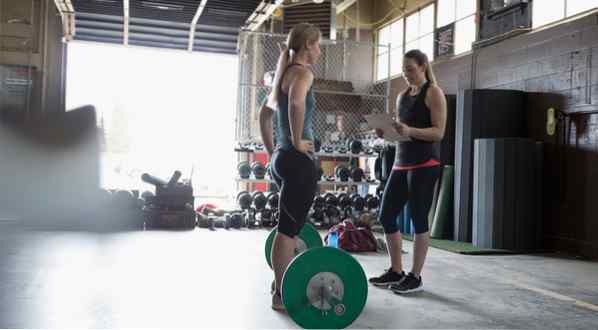
How to Choose a Trainer Certification Based on Your Goals and Budget

Have you ever thought about being a personal trainer or a fitness influencer or running your own gym or CrossFit Box? That new career could be closer than you think-and you could very well help transform hundreds or thousands of lives and help reverse the staggering adult obesity rates in the U.S.
Make no mistake, the road to becoming a trainer is not designed to be easy, and isn't as simple as taking a test. Becoming a quality trainer takes years of education and hands-on experience-you'll have to dig deep for this career. But starting the lifelong journey to change people's lives as a trainer, coach, gym owner, or nutritionist all begins with the first step. Yet with so many programs to choose from-and so many debatably less-legitimate certifying organizations crowding the great ones-how do you pick your ideal program?
We sat down with the directors of certification and elite trainers from each of the top fitness certification organizations to pinpoint the strengths of each one. No two are exactly alike, but by peeking behind the curtain of their curricula and missions, this guide may help you find your perfect fit to start a new career ASAP.
1 of 8

Mike Harrington / Getty
American College of Sports Medicine
The roots of this organization go back to 1954, when it was started by physicians and physical educators. It has since grown to include 50,000 members and has an even broader reach beyond.
ACSM has uniquely strong roots in university partnerships, which means direct access to university-level internships across the country-and that's what sets ACSM apart, says Francis Neric, M.S., M.B.A., national director of certification. Its most popular certifications include personal trainer, group exercise instructor, and exercise physiologist; plus, it also has a clinical exercise physiologist certification.
“ACSM's personal training certification and hands-on programs empower students to develop effective programs out of the gate,” Neric says. “Science is learned in the classroom; and art-the art of training others and being a change agent to clients-is learned on-site,” he explains. “The best lessons are learned from peer-to-peer interaction, which makes our internships so effective.”
About 77% of students have bachelor's or master's degrees, but one of the greatest predictors of success with ACSM is whether you're able to master client onboarding/ risk assessment, workout programming, evaluation of programming efficacy, and behavior change. To get there, ACSM offers access to “textbooks, PrepU [a program offering scalable real-time exam-prep based on your answers], plus webinars, live training sessions, and summits and regional conferences.” What's more, as with most of the other organizations, it emphasizes continuing education.
ACSM is the science behind the fitness, shown by its role in maintaining scholarly journals like Medicine & Science in Sports & Exercise, so for those of you who like to geek out on fitness as much as we do, ACSM certification may be right for you. It also allows veterans to use GI Bill money to pay for the certification exam.
Website: acsm.org
2 of 8

Mike Harrington / Getty
National Academy of Sports Medicine
NASM started more than 30 years ago and has ballooned in popularity since; in the past 10 years alone it has certified or re-certified 190,000 professionals.
Its most popular is Certified Personal Trainer (NASM-C.P.T.), which “emphasizes the importance of stability and injury prevention as a foundation for a fitness program, and because of that, many collegiate and professional sports teams now use our model,” says Kellie Roman, M.A., NASM-C.P.T., C.E.S., P.E.S., master instructor.
“Our NASM-C.P.T. program is based on the most current scientific research in human movement and injury prevention,” Roman adds. There are also Master Trainer, CES (Corrective Exercise Specialization), FNS (Fitness Nutrition) certs, and many more.
Candidates demonstrate their knowledge in a variety of ways for the NASM-C.P.T. exam, she says. Pre-exam you can review the textbook and online training modules and even get a more hands-on experience by attending a live workshop presented by NASM.
After passing the exam, new trainers can apply their knowledge and jump into the day-to-day career experience through the NASM-C.P.T. Development Program. “Here they are assigned to a NASM Development Program host facility in their area, where they receive 80 hours of on-site, hands-on experience with fitness clients, plus weekly online and practical assignments, guided by an NASM mentor and coach.” Bonus: This program o ers a job guarantee within 90 days of completion.
NASM sets you up for a lifelong process of upping your game while focusing on how to keep clients progressing safely and steadily.
Website: nasm.org
3 of 8

Mike Harrington / Getty
American Counsel on Exercise
ACE's overall approachability-from its colorful website, online blog, exercise library, and salary surveys to its training videos on Instagram-make it easy to see the full picture of how you can become a personal trainer. And that's why ACE has more than 70,000 certified professionals in its fit fam.
Its top three NCCA-accredited certifications include certified personal trainer, group fitness instructor, and health coach. It also offers plenty of continuing education courses on trending nutrition topics, chronic condition specialties, and more at affordable prices.
Formed as a nonprofit in 1985 at the height of the U.S. health and fitness craze, ACE aims to help populations living with chronic conditions and obesity. ACE works to stay in front of training and nutrition models, just like other top fitness certification organizations on this list; and it does a great job, which you can tell from recorded workshop topics like foam rolling, whole foods, and “How We Got It All Wrong: Nutrition Recommendations for Heart Health.”
We also love that ACE gives scholarships to veterans and those working in underserved communities.
Website: acefitness.org
4 of 8

Hero Images / Getty
International Sports Sciences Association
ISSA is the only fitness certification organization recognized by the U.S. Department of Education. What that means for your wallet is that you can take out a student loan to more affordably get certified and pay it back gradually. That's a boon for opening up the field to a wider array of trainers; plus, it offers veteran tuition assistance.
Started in 1988 by Sal Arria, M.S.S., D.C., and world champion powerlifter Frederick “Dr. Squat” Hatfield, Ph.D., ISSA now has 200,000 certified members. Its most popular certifications are personal trainer and specialist in fitness nutrition, plus it offers an associate's degree in exercise science, and in the near future it plans to o er a bachelor's degree.
To stay on the cutting edge of nutrition specifically, “we use a combination of factors that regulatory bodies have determined effective, and we also interview researchers to be ahead of the trends in journals,” says ISSA chief operating officer Patrick S. Gamboa, B.S., M.S.S. ISSA also has a mastermind sports nutrition advisory council, which includes well-known medical experts such as Richard Gerardo, D.C., C.S.C.P., DACBN; and Frank Katz, M.D.; and sports nutritionists like Kim Dolan Leto. “This helps us utilize both research-backed science plus on-the-ground sports nutrition,” Gamboa explains. “We reevaluate our materials constantly.”
No matter your need, ISSA offers unlimited support. “You can call anytime. We'll respond via email, chat, or phone within 24 hours,” Gamboa says, adding, there are many more perks. “First, courses are available on multiple devices. Second, every enrolled trainer gets a free website with 24 different templates and gets a nutrition platform for their clients.” In addition, “we have a free video library so you can quickly learn how to create your own video/podcast, handle legal issues, craft online infomercials, get started in marketing, branding, etc.” Plus, you'll get health insurance and business cards.
On the professional track, all exams are taken through its online platform Proctor U. For some, you'll “do a written portion where you use case studies and do the research-going beyond multiple choice. Or there is a video portion, for example, so you can develop more elective programs. For us, each course is a stepping stone to keep your education progressing.”
Website: issaonline.edu
5 of 8

Westend61 / Getty
National Strength and Conditioning Association
Founded in 1978, the NSCA is a nonprofit certification organization. The Certified Strength and Conditioning Specialist (C.S.C.S.) is its most popular, says certification director Torrey Smith.
Those holding this credential “apply scientific knowledge to train athletes for the primary goal of improving athletic performance,” he says. The next most popular certification is the NSCA- Certified Personal Trainer (NSCA-C.P.T.).
Its C.S.C.S. curriculum is in-depth, so a bachelor's degree is required, as is passing a two-section certification exam: “Scientific Foundations covers exercise science, anatomy and physiology, psychological techniques, and nutrition; and the Practical/Applied section is designed to assess a candidate's knowledge of program design, exercise techniques, evaluation, and organization,” Smith explains.
The 14-question NSCA- C.P.T. certification exam, Smith adds, “covers client consultation, programming, exercise techniques, and safety protocols.” The NSCA then links students with schools with “standardized, approved curricula in undergraduate and graduate settings” and afterward offers internships in its headquarters performance center in Colorado Springs, CO. Plus, its Assistantship Program pairs C.S.C.S. grads with experienced strength and conditioning coaches.
The NSCA also has a large video library, conference sessions, hands-on practical training, career development, recorded webinars, and podcasts. To remain certified, you have to complete Continuing Education Units (CEUs) every three years.
NSCA puts out five publications, including the Journal of Strength and Conditioning Research, a peer-reviewed research journal.
Website: nsca.com
6 of 8

Hero Images / Getty
CrossFit Level 1
CrossFit has taken off like wild re since its launch by gymnast Greg Glassman in 2000. There are now more than 14,000 CrossFit affiliates and 100,000 trainers.
The Level 1 (L1) Certificate Course has no prerequisites and is just the first in a series of four total levels you can get, along with specialty courses. To obtain L1 you have to take a two-day course and pass the L1 test, plus repeat the course every five years or get a higher-level credential. Courses are held across the world and throughout the year.
Unique to CrossFit courses, this learning and testing occurs over two full days, and during it you'll learn the fundamentals of CrossFit methodology necessary to train others responsibly. Its ultimate goal is to educate trainers at L1 and beyond to have deep knowledge of the foundational movements, movement mechanics, programming, and nutrition.
Specifically, students need to be able to, among other things, define CrossFit and functional movement; define/calculate work/power/intensity/variance; articulate CrossFit's definition of health and fitness; explain how technique is related to coordination, accuracy, agility, and balance; and understand and explain the importance of nutrition for fitness and health.
CrossFit trainers are notoriously community-oriented and ready to lend a hand or shed light on a question you have. That makes learning and succeeding as an L1 and beyond a fun and never-ending process, which is exactly why CrossFit started in the first place.
The Level 1 Course is American National Standards Institute (ANSI)-accredited.
Website: crossfit.com
7 of 8

Hero Images / Getty
FitOps Foundation
This all-expenses-paid training is for current or former U.S. military service members who want to become elite personal trainers. FitOps looks for passionate service members ready to make their civilian life a strong one. You have to apply and get accepted to this Certified Veteran Fitness Operative (CVFO) program. And for three weeks you'll get a blend of class time (covering anatomy, physiology, and nutrition) and hands-on time at the gym that'll prep you to help change lives and become an industry professional CVFO.
Website: fitops.org
8 of 8

Hero Images / Getty
How Much It Costs
ACSM:
- $279, member cost;
- $349, nonmember;
- $175, retest; plus study materials
NASM:
- $699, self-study;
- $999, premium self-study;
- $1,299, guided study;
- $1,999, all-inclusive
ACE:
- $299, basic package with digital study materials;
- $499, plus package with digital and hard copy study materials
ISSA:
- $799, each individual course
- $899, coach beginner package;
- $999, elite trainer package;
- $1,999, master trainer package
NSCA:
- $300, member cost;
- $435, nonmember
CrossFit:
- $1,000, Level 1
- $1,000, Level 2
FitOps:
- Full scholarship, by invitation only



Nimeni nu a comentat acest articol încă.